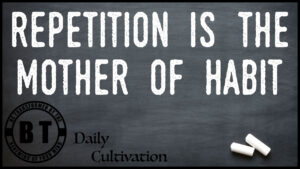
A pattern executed with repetition consistently over the course of time creates a habit. A habit is defined as, a settled tendency or usual manner of behavior; an acquired mode of behavior that has become nearly or completely involuntary. Habits become your subconscious default settings. “Sub” in subconscious means below, your subconscious is below your conscious mind. It is your auto pilot program that allows your body to function while your conscious mind is focused on something else.
For example, in basketball, a player practices dribbling the ball. These drills used consistently over the course of time creates and increases the skill, ability and the habit of dribbling. The goal of this repetition is to make dribbling second nature. It becomes a habit and a subconscious program that your body puts into practice without you needing to think about it. That way you can move the ball down the court and focus on your opponents and the play that you are running instead of what your hands are doing with the ball.
Another example of this subconscious programming is when you are driving down the road and someone cuts you off. Before you were cut off you were happy and calm, and as soon as you were cut off you became instantly angry. If you become instantly angry it’s because you have taught and trained your body through repetition to respond in anger in this type of situation. Remember the definition of a habit is an acquired mode of behavior that has become nearly or completely involuntary. So it happens without you making a conscious decision, this is what you would call a reaction. A response is when you consider and decide what your course of action will be. A reaction is like a reflex, your body is put into motion without you having to think about it.
The example of the basketball player is one of creating a habit intentionally. The repetition and disciple of practicing over time creates a habit that will serve the player. The example of the person being cut off while driving is and example of an unintended habit. Meaning if you knew what kind of habit you were creating you wouldn’t have created it. How do we create a new habit? How do we override an old subconscious program with a new one? With repetition.
To change an existing habit you first must become aware of it. Awareness is step number one in changing the way you think. You have to be able to see what you are doing to be able to consider how to do it differently. Step two is to stop. In the example of being cut off while driving, when you become aware that you are angry, stop. Take a deep breath, use empathy and understanding to calm down and let go of the “offense”. Remember a time when you accidentally cut someone off. Remember that everyone is trying to get somewhere and that the car manufacturer gave you a brake pedal for the purpose of being able to slow down and brake. In this way you train yourself to see someone cutting you off as no big deal instead of a huge act of disrespect. Every time you find yourself getting angry, employ this strategy and over a short period of time you will intentionally transform an undesired reaction into a desired response. That is powerful!
